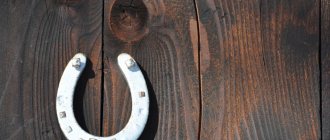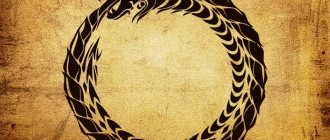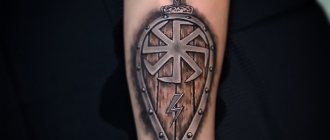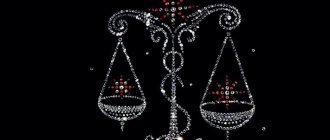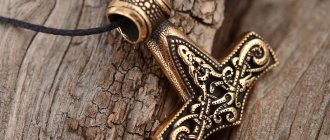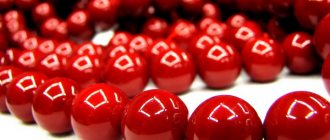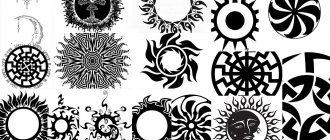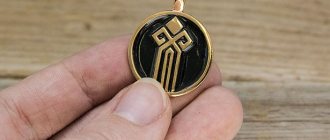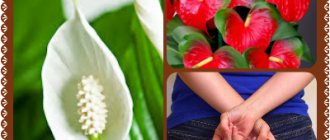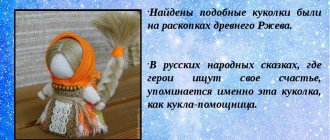Slavic-Aryan people
It has always been distinguished by its original and unique culture, about which numerous treatises have been written by famous and not so famous researchers, starting with Herodotus and ending with modern historians. Strength of spirit and a unique desire to know the unknown are not all the special character traits of the ancient Slavs. In order to convey their sacred knowledge accumulated over centuries, the Slavs used a combination of metaphors and mythology.
Pagan pantheon of gods of the Slavs
Table of pagan gods of ancient Rus':
| No. | Deity name | Purpose |
| 1 | GENUS | Supreme god of heaven and earth |
| 2 | HORSE | Sun God |
| 3 | YARILO | God of the spring sun. Son of Veles |
| 4 | DAZHDBOG | God of fertility and sunshine |
| 5 | SVAROG | Master of the Universe. God of the sky |
| 6 | PERUN | God of lightning and thunder |
| 7 | STRIBOG | God of the Wind |
| 8 | VELES | God of fertility (cattle) |
| 9 | LADA | The female embodiment of Rod |
| 10 | CHERNOBOG | Lord of the forces of darkness |
| 11 | MOKOSH | Goddess of the earth, harvest and female destiny |
| 12 | PARASKEVA-FRIDAY | Mistress of revelry |
| 13 | MORAINE | Goddess of evil, disease and death |
Ancient Slavic god Rod
This is the supreme god who rules over all things in the Universe, including all other gods. He heads the pinnacle of the pagan pantheon of gods. He is the creator and ancestor. He is omnipotent and influences the entire cycle of life. It exists everywhere and has no beginning or end. This description fully corresponds to the concept of God of all modern religions.
The genus governs life and death, abundance and poverty. No one has ever seen him, yet he sees everyone. The root of his name is sewn into human speech - into the words with which people interpret (voice) their dominant spiritual and material values in the material world. Birth, relatives, homeland, spring, harvest - Rod is present in all this.
Hierarchy of pagan gods of Rus'
Under the leadership of the Family, all Slavic deities and other spiritual entities are distributed according to levels corresponding to their impact on the everyday affairs of people.
The top level is occupied by deities who manage global and national affairs: wars and ethnic conflicts, weather disasters, fertility and famine, fertility and mortality.
At the middle level there are deities responsible for local affairs. These are the patrons of agriculture, crafts, fishing and hunting, and family concerns. People liken their face to their own.
The stylobate of the base of the pantheon is assigned to spiritual entities whose physical appearance is unlike that of a human. These are kikimoras, ghouls, goblins, brownies, ghouls, mermaids and many others like them.
The Slavic hierarchical pyramid ends here, unlike the ancient Egyptian one, where there was also an afterlife with its own governing deities and laws, or, say, the gods of ancient Greece, where the basis was a numerous pantheon of gods.
Gods as the basis of Slavic mythology
The basis of the mythology of the Slavs is the Slavic gods, amazing creatures whom our ancestors worshiped for centuries, offered gifts, and sang songs of praise. It is difficult to talk about whether there were real people behind the images of the gods, and this issue is quite controversial. Perhaps in a few centuries the secret of the origin of the gods will be revealed, but now we will talk about the pantheon of Slavic gods in a slightly different context - their symbols, essence and ideas that were invested by our ancestors in each bright and unique image.
This section is dedicated to all the gods who occupied a certain place in the life and way of life of our ancestors. Gods who were worshiped, feared, praised and revered. If we turn to the results of studies of chronicles and archaeological excavations, then on the territory of Ancient Rus' in different time periods the gods of Slavic mythology somewhat changed their meanings - Light (Yasuni) and Dark (Dasuni) were somewhat different in different parts of Rus'. The reason for this was internecine wars, attacks by external enemies, a rethinking of the nature of things, and inevitable progress. But at the same time, the list of Slavic gods and the scheme of the Slavic gods remained practically unchanged - the supreme god was Rod (although there are references to Perun as the world ruler), Lada is one of the incarnations of Rod, which combines vital energy, loyalty and love. It is worth saying that the list of gods of Slavic mythology at different times varied somewhat and changed its composition, so it is impossible to say unequivocally who was on this list. It is impossible to say one hundred percent that the data about the gods presented on our website has real documentary evidence - we have collected maximum information not only from open sources, but from highly specialized scientific works, so we hope that this data will also appeal to connoisseurs of the commandments of the Slavic gods , and to everyone interested.
Kostroma
This Slavic goddess was the sister of Kupala and has long symbolized the element of primordial water, fertility, harvest, summer warmth, helping lovers meet each other. All sources indicate that Kostroma and Kupala are indivisible images, since, not knowing that they were brother and sister, they fell in love with each other, but could not come to terms with the fact that they could not be in the place as lovers. Kostroma has always symbolized maiden purity and femininity, embodying the image of true love - sincere and at the same time tragic. Want to know more about the goddess? That full description is here ➡ go.
Kupala
The solar deity (other possible names are Kupailo or Kupaila) but was often called Kupailo. It is the apotheosis of all the energy of the Sun and is similar
primordial elemental fire. It is impossible to imagine Kupala separately from Kostroma, its sister, personifying water. According to legend, Kupala and Kostroma, not knowing that they were brother and sister, were inflamed with true love for each other, but upon learning about the blood ties, they committed suicide together. The image of Kupala clearly expresses the concepts of our ancestors about honor and justice, that truth always wins. The night of Ivan Kupala also migrated to Christianity, combining paganism and biblical subjects. Invariably, the symbol of this god helped in love, recovery, spiritual and physical cleansing. Do you want to know more about God? That full description is here ➡ go.
Mara
They can also be called (Morena, Morana.) The image of Mara simultaneously combines fertility and death, witchcraft and justice. In some sources you can find information that Mara is the daughter of Kashchei, but in most literature it is widely believed that she is one of the three daughters of the first generation of gods who appeared from sparks from Svarog’s hammer on the sacred Alatyr. Mara always seems to be a beautiful young girl, but her beauty is only cold - fair skin, dark hair, bright clothes. This goddess could control the elements and various energies, but at the same time she used her powers only if she happened to be friends with Yaga. The symbol of Mary is ice, which simultaneously combines energy, cold, and strength, so for the ancient Slavs this symbol was negative. Often it was Mara who symbolized winter, so the Slavs, during prayers to her, asked for less severe cold and for the speedy onset of spring. Want to know more about the goddess? That full description is here ➡ go.
Symbols
Makosh
The Goddess Makosh is as ancient as the great Family itself. She is original and she gave birth to gods and life. In this case, Rod and Makosh are considered as two opposites - male and female, which gave rise to the entire universe. The very name of the goddess Makoshi comes from the merger of two words: “kosh” or “kosht”, which means fate, destined, and the prefix “ma”, which is an abbreviation for the word mother. It turns out that Makosh is a mother who knows the fate of everything generated by her. It is worth noting that the image of fate among many ancient peoples was associated with the cloth that was woven by three goddesses. In ancient Greek mythology, these were the Moiras, and in the Slavic epic, this niche was occupied by Makosh and her two assistants - Dolya and Nedolya. They, together with the mother of all destinies, the goddess Makosh, spun the fabric of the universe, and they tied together the lives they lived and the deeds they committed. Only they had the right to decide who should live and who should die. The Slavs revered the goddess Makosh as the great Spinner of Fates.
Want to know more about the goddess? That full description is here ➡ Go
SYMBOL
Perun
If the ancient Slavs heard thunder, then they knew that it was the work of Perun, the patron saint of valiant warriors, the son of Lada and Svarog, the most famous of the Svarozhichi family. Regardless of whether he is related to the supreme gods (son or grandson), he is one of the most famous gods worshiped by our ancestors. Many can draw an analogy with the ancient Greek Zeus, but Perun was always more loyal to people and ready to stand up for them. The image of Perun was imitated by many Slavic military leaders - a red cloak, a mighty horse and a club. The symbol of this god is an ax, which is both a weapon and a talisman for warriors, or a swastika. Prayers to Perun were always said by defenders of their native land, who went for a just cause. In Christianity, Perun was not forgotten - he was simply replaced with the image of the prophet Elijah. Want to know more about God? That full description is here ➡ go.
Rune ➡
Genus
Rod is more than just the creator of the world. It was thanks to him that the universe appeared in the form that is familiar to us. The ancient Slavs preferred not to think about where Rod came from, since the appearance of the supreme god is not a topic for discussion by mere mortals. Before Rod appeared, there was neither light nor darkness, there was nothing. It was thanks to him that all living things appeared on earth. After the creation of the world, Rod divided it into Reality, Rule, Nav. The genus is the progenitor of all Slavic gods and ancestors. The ancient Slavs especially revered this god, which is why in our language so many words associated with the most precious thing take their roots from the word “clan”. The symbol of Rod is very reminiscent of a modern photograph of our Galaxy from space - a stylized swastika (where such an accurate image came from is a question for historians and theologians). Want to know more about God? That full description is here ➡ go.
Symbol ➡
Semargl.
This god has always symbolized the original fire and fertility. Under his leadership, all the Svarozhichi became an invincible force, and he often helped Svarog and Perun in the fight against darkness. Little is known about the power of Semargl, but all sources emphasize that he was a kind of catalyst for other gods. According to many, it was he who acted as the messenger of the gods, transmitting to Reality the information necessary for everyone. Semargl was represented in different ways - sometimes in the form of a warrior, sometimes in the form of a fiery dog, sometimes in the form of a fairy-tale bird (most often a falcon that brings victory in great battle). Want to know more about God? That full description is here ➡ go.
Symbol ➡ Symbol ➡
Veles
One of the wisest gods, who was a werewolf, patronized the arts. Veles ruled over sorcery, since only he managed to know both light and dark forces. One can talk for hours about the secret knowledge that he possessed, especially since Veles was subject to the elements and he could change the rules of the universe. In the culture of the ancient Slavs, Veles was especially valued as the patron of family farming, prosperity and fertility. Travelers revered this god no less, since he brought them good luck on the road. He appeared to people either in the guise of a gray-haired old man or a bear. By the way, the six-pointed star, known to everyone as the Star of David, has always been considered a symbol of Veles. The ancient Slavs prayed to this god for many reasons - they asked for good luck on the journey, peaceful sleep, and thanked him for the success of some events. Want to know more about God? That full description is here ➡ go.
Symbol ➡
Yarila or Yarilo
Quite often this god was called Jaromir and he symbolized passion, uncontrollable energy and spring. This illegitimate son of Veles personified spring warmth and sincere feelings. Yarilo is the sun god in Slavic mythology, but the spring Sun is warm and pleasant. The name of God came into use among the Slavs as a symbol of the retreat of cold weather. The symbol of this god is a five-pointed star, which found no less application in Slavic mythology than in the occult sciences of European cultures. The god of youth and carnal pleasures, Yarilo loves all women, delighting them with the warmth of the spring sun and sincere feelings. Jaromir was always portrayed as a young guy who is the dream of all girls, earthly and heavenly. Want to know more about God? That full description is here ➡ go.
Rune ➡
Stribog
Stribog was one of the first born from the sparks of the gods or from the breath of Rod (versions vary somewhat, but they all agree on one thing - he is one of the highest gods). Stribog is rightfully considered one of the militant gods who fight on the side of the world. He always symbolized the wind, he patronized birds and simply the elements of air. The ancestors revered Stribog no less than Perun, since he was from the older generation of deities. They imagined him as just a gray-haired old man with a bow in his hands, not particularly talkative, but at the same time strong and fair. Due to the fact that Stribog was considered the god of the wind, he was especially revered by merchants and traders, since it was he who filled their sails. This god was also respected for the fact that he could be uncontrollable and destroy with a hurricane everything that he did not like. Want to know more about God? That full description is here ➡ go.
Symbol ➡
Dazhdbog
Dazhdbog is the god of fertility and the god of the sun in Slavic mythology, and mention of him as a solar god is found in many sources that have survived to this day. Naturally, it was always symbolized by the disk of the Sun, on whose position in the sky the harvest depends. God has always been considered peace-loving, but in the original war he took part on the side of the light. He was always represented as a mighty hero in golden armor. Dazhdbog was rightfully considered one of the highest gods, so his idols were located in almost all settlements, since it was very important for the Slavs to get a good harvest and prosperity. The god had his own rune, which was often applied to the tools on which the harvest depended. Want to know more about God? That full description is here ➡ go.
Symbol ➡ Rune ➡
Alive
This is the female embodiment of the Family, which patronizes Reveal and give life. According to many sources, Zhiva had a strength similar to that of Rod. Alive could change matter, giving energy to all who deserved it. If you look at it, she is the first female image in the pantheon of Slavic gods, the scheme of which is quite diverse. Zhiva had a sufficient supply of wisdom and knowledge not to interfere in people’s lives, so there are not as many mentions about her as about other gods. The female images of the gods - Lelya, Lada and Makosh - are an interpretation of Zhiva at three different ages, as they symbolize the stages of a woman’s formation as a continuator of the family. Zhiva was presented as a middle-aged woman who patronized all living things, especially plants. Want to know more about the goddess? That full description is here ➡ go.
Symbol ➡
Lada
Many sources doubt whether she was the daughter of Svarog or his wife, but everyone agrees that she was the goddess of beauty, love and happiness. The family hearth was also protected by Lada, personifying the ideal of a woman, but not a woman-mother (it is important not to be confused). Lada is the image of a woman who is ready for marriage, ready to love, ready to give her warmth to a warrior. This goddess collected in herself the power of the sun of all Yasunya. Her image contains almost all the positive qualities of the light gods - wisdom, honesty, sincerity. The Lada Star was rightfully considered a symbol of the feminine principle and was made of gold, copper, bronze and was worn by women throughout their lives, since wisdom and prudence should always accompany it. Want to know more about the goddess? That full description is here ➡ go.
Symbol ➡
Svarog
Svarog was rightfully considered the first earthly image of the Family and was the father of the first generation of Slavic gods. He is credited with creating the land where people live. Svarog has long symbolized an experienced warrior-defender, who in case of danger gathered all the light gods under his banners. The symbol of Svarog is an all-destroying and at the same time life-giving fire. In Slavic mythology, he was the patron of labor, since only labor allows one to create something great and significant. A star with eight rays is a symbol of Svarog, which very often denoted the sacred stone Alatyr. God was at the same time a peaceful blacksmith and a powerful warrior who did not let go of the hammer, which turned from a tool into a formidable weapon. Want to know more about God? That full description is here ➡ go.
Symbol ➡
Lelya
For a long time, spring among the Slavs was a symbol of the awakening of life, and therefore its image is the young goddess Lelya, who combines spring, girlish love and beauty. The image of Lelya is that of a pure young girl who is about to get married. Lelya was rarely identified with everyday life, since she thinks more about the spiritual rather than the material. Even the name “Lelya” itself is translated from Sanskrit as “game”. This goddess was symbolized by the birch tree familiar to the Slavic gaze - fragile, joyful and playful. Lelya patronized all young girls who dreamed of getting married, gave them sincere feelings and selected a couple with whom they could live their whole lives carefree. Want to know more about the goddess? That full description is here ➡ go.
Rune ➡
Horse
God of the sun in Slavic mythology, the winter sun, along with Yaril and Dazhdbog. God is positive, protecting people in the cold season from Chernobog. He can be associated with Santa Claus - he is ruddy, cheerful and a little sad because he cannot constantly protect people from dark forces. Khorsu is the lord of winter, who has the power to calm a blizzard and make the winter warmer or colder. Khors enjoyed special honor among farmers, since the harvest of winter crops directly depended on the mood of the god. The ancient Slavs tried not to anger this god, since on the road he could send a blizzard and hit with severe frost; if you treat him with respect, he granted a warm winter with a lot of snow. Want to know more about God? That full description is here ➡ go.
Symbol ➡
Belobog
Belobog in Slavic mythology had many names that symbolized him as the bright god of the supreme pantheon. Belobog has a clear opposite - Chernobog, but at the same time embodies goodness, honor and justice. He was always depicted as a gray-haired, wise old man in a white robe. This is perhaps the only god who has nothing to do with military affairs - he did not participate in the battles of the gods. The image of Belobog reflects the basic principles of the universe, the structure of the world and its purpose. According to the myths of the ancient Slavs, he helped those who worked in the field and at home, were not lazy and walked towards their intended goal through obstacles. Want to know more about God? That full description is here ➡ go.
Symbol ➡
Chislobog
Chislobog is credited with systematizing and streamlining the movement launched by Veles, therefore he belongs to the highest gods. It was Chislobog who gave the ancient Slavs not just a calendar, but a whole system of predicting events based on the energy of the earth and space. Chislobog is the patron of stability and change, a god who protects the human race, a god who administers judgment of conscience after death, defining a person by his actions. The priests of Chislobog were especially revered, since they were able to predict the future and had unique knowledge. It is difficult to find an image of this god in the sources, since he tried not to show himself to people, controlling the river of time, which is merciless. Want to know more about God? That full description is here ➡ go.
Chernobog
The ancient Slavs often called Chernobog the Black Snake, in which all the dark forces are collected. He was rarely revered and no idols were erected. If we talk about absolute evil, then it is he who personifies it, so his main mission is the destruction of all living things. He was depicted in various forms - in the form of a basilisk, and in the form of a serpent, and in the form of a raven. In terms of his abilities and strength, he is not inferior to any god, so the gods of Reveal were able to defeat him only by uniting. But at the same time, our ancestors understood that there is a part of Chernobog in every person - this is his dark side. It cannot be said unequivocally that Chernobog’s actions were aimed only at destruction, because without the destruction of the old it is impossible to build a new one. It is worth remembering that good exists only in the presence of evil, which is why it is impossible to defeat Chernobog, because there is a part of it in every person. Want to know more about God? That full description is here ➡ go.
Symbol ➡ Rune ➡
Ruevit
Ruevit is rightfully considered the patron of warriors who defend their lands. He protects the stars and lands of Yarila and Mokosh. The main purpose of God is the fight against dark forces, in which he is helped by no less militant gods. Ruevit's main weapon is the sword and fire, which he is ready to use at the moment when it is necessary to protect the weak and offended. This god did not protect all the borders between Reality and Navya, but only certain, most difficult areas, giving Perun and his brothers the opportunity to pay more attention to other areas. Ruevit is an idealized warrior who has been an example for Slavic men since birth. Want to know more about God? That full description is here ➡ go.
Symbol ➡
Radogost
Radegast (a more correct version of Radegast or Radoghast) is very often called Radegast - this is a god who was famous for his hospitality, helps in trade and brings a rich harvest. According to experts, Radegast is one of the interpretations of Svetovit. The god looked very interesting - a young half-naked youth with animal symbols and armed with an axe. Quite often, warriors worshiped Radogost as a warrior god, and not as a god of life and wealth. But God cannot be called evil; he helped in trade and diplomacy. Very often, the ancient Slavs considered Radegast as the embodiment of kindness and openness. Archaeologists confirm that in the territories where the ancient Slavs lived, there were many sanctuaries of Radogost, which testifies to his honor and respect for him. Want to know more about God? That full description is here ➡ go.
Baba Yaga
The ancient Slavic Baba Yaga (Goddess) was the ancestor of the legendary heroine of Russian fairy tales. She was a dark sorceress, the daughter of Viy. Do not think that she was a scary old woman; she is often described as a young woman who is comparable in beauty to Lada. Baba Yaga understood the languages of animals, animals and plants. Yaga was indifferent to the wars of light and darkness, considering them not worthy of her attention. She was the wife of Veles, who sincerely loved her for who she was. Yaga ruled the upper underground kingdom of Navi, which no longer belonged to the world of the living, but was not the world of the dead either. Baba Yaga was neither god nor man, she was rather a collective image of unknown forces that could not be classified as either good or evil. Want to know more about the goddess? That full description is here ➡ go.
Koschey
Koschey, who is correctly called Kashchey, is one of the most famous characters in the mythology of our ancestors. Kashchei is the son of Chernobog, distinguished by his wisdom and malice towards all living things. He practically did not take part in the battles between darkness and light, preferring to plot intrigues in his dark kingdom. Koschey looked like a gray-haired, angry old man who could turn into a raven. Kashchei’s peculiarity was that he could control the dead, who were ready to carry out his any, even the most cruel, plan. The image of Koshchei found a worthy place in the fairy tales and legends of the Slavs as the most negative hero, possessed of a deep mind and special cynicism. He walked in armor enchanted by Mara herself, which was not afraid of any earthly weapon. Want to know more about God? That full description is here ➡ go.
Volkh
Volkh is the son of the Fire Serpent and the Earth. He was a werewolf, identifying in himself the courage and rage of the Slavs. According to legend, the Fiery Serpent took possession of Mother Raw Earth by deception, and when Volkh was born, his goal in life was revenge for his mother, for all those offended and humiliated. The image of Volkh was associated with a young warrior who is ready to protect his native land from misfortunes and dangers. There is a legend that the armor and weapons were forged by Svarog himself, and this god received all his skills from the best teachers - Mokosh, Veles, Yaga. Volkh symbolized a warrior who does not just mindlessly rush into the thick of battle, but makes the most accurate decisions and is able to control any army of comrades. Want to know more about God? That full description is here ➡ go.
Vyshen
Vyshen is one of the incarnations of the great Family, which at all times was especially revered by the Slavs, who loved freedom of spirit, soul and thoughts. This god was associated with the universe and its endless expanses. Vyshen was rightfully considered the patron saint of all Slavs and Aryans on earth. But at the same time, God was especially strict towards those who tried to misuse the path of Spiritual development for base purposes. He is especially supportive of those who seek new knowledge and try to comprehend everything incomprehensible. An honest and noble person could always count on the support of this god. If we turn to chronicles and legends, then Vyshen is a symbol of wisdom that operates in all worlds. A gray-bearded old man holding a sword is always ready to help believers and punish those who have strayed from the true path. Want to know more about God? That full description is here ➡ go.
Tara
This goddess patronized all living things, especially forests. Kindness and sincerity are mandatory character traits of Tara. For her, a person is not just a creature, but a part of living nature, which is the basis of everything around. There is quite a lot of controversy around the image, but everyone agrees on one opinion - this is a young girl with dark hair who spends most of her time searching for medicinal herbs and roots. Tara can be called a real witch who knows perfectly well about all the secrets of the forest and not only about them. She has fundamental knowledge about the structure of the Universe, but does not tell it to anyone. She is often called Dara, as she gave the Slavs warmth, love and joy, without demanding anything in return. Want to know more about the goddess? That full description is here ➡ go.
Indra
Even the highest gods have assistants; Perun has Indra, who always helps him in the battles of light and darkness. Indra symbolizes courage, bravery and hatred of all enemies - internal and external. Indra is a celestial warrior who does not descend to earth, but wages a constant battle in interstellar space. Indra is the keeper of the Weapon of Retribution, which brings victory to the forces of light, while he is the main one among the 30 protective gods. Indra was especially revered by warriors, since he personified courage and steadfastness in the fight for a just cause - the protection of his home and loved ones. It combines the strength and wisdom that are inherent in all Slavic warriors fighting for a just cause. Want to know more about God? That full description is here ➡ go.
Zimun
This is the Mother of God of Perun, Veles and many other high gods. Zimun is a collective image of a loving mother, waiting for her children, ready to give everything she has for their happiness. From time to time, the goddess turned into a Heavenly Cow, since in this form it is much easier to control the heavenly herds. Since ancient times, Zimun, in the minds of the Slavs, looked like a beautiful older woman, from whom warmth and kindness emanated. Her maternal feelings for all people, not only her children, were especially emphasized. If we talk about the image of a cow, then it symbolized the wealth and well-being that such cattle brings to the house. Prayers to Zimun were most often addressed by women who were expecting their sons from military campaigns and who wished well-being and a comfortable life for their descendants. Want to know more about the goddess? That full description is here ➡ go.
Howala
There is no specific information about where Khowala came from, all that is known is that he looked like a gray-haired old man who was always on the move across the endless world. He never speaks to anyone, only smiles and studies everyone with his piercing gaze. The main purpose of this demigod is to bring light, life and joy to everyone. With his gaze, he incinerates evil and deception; objects and people he looks at can turn to dust. Hobala is often called the avenger god, who is a punishment that sooner or later overtakes the culprit. It is impossible to say unequivocally whether it belongs to light or darkness, since little is known about its appearance. Khowala is a symbol of justice and noble retribution. Want to know more about God? That full description is here ➡ go.
Goddess Karna
The goddess Karna is a controversial figure in Slavic mythology. Perhaps this goddess was revered by our ancestors as responsible for the rebirth of souls, for the continuous circle of existence in the universe. In the historical treatise “The Word of Saint Gregory” the goddess Karna is mentioned under the name Koruna. There is also a mention of the companion of Karna, the goddess of Jelly. It is quite possible that they personified destiny and fate in human destiny. The goddess Karna is also present in the Roman pantheon, and she was revered by the ancient Romans as the goddess of human flesh. This version is supported by the fact that the etymology of the name of the goddess Karna is supposedly rooted in the word “corn”, which means “meat”, “flesh”.
In a later period, the ancient Romans worshiped the goddess Karna under the name Carda and even Cordelia. She was revered as the goddess of door locks. Of course, this is a slightly strange purpose for a goddess, but we should not forget that the words we perceive today in the literal sense were previously perceived by our ancestors more deeply. If among the Slavs the goddess Karna was the goddess of the rebirth of the soul, then she guided souls from one world to another, and back. For the transition, gates were needed, call the doors what you want. Perhaps in the understanding of the ancient Romans, Karna was a goddess who guarded the passages to the other world. Want to know more about the goddess? That full description is here ➡ go.
Devana
Many people know that in Roman mythology the goddess of hunting is Diana, and in Slavic mythology Devan. This young slender hunter was considered the patroness of hunters and the entire forest world. But she did not like hunting for fun, not food (those who did this died from the bites of poisonous snakes). Devana always had a bow and arrows in her hands, and on her shoulders a cloak with a bear or wolf's head. Despite her closeness to nature, Dewana was not symbolized with totem animals, since she was not a warrior, but a hunter. Shrines to this goddess are still found in old forests, which could not be entered on a moonlit night when she went hunting. At the same time, Devana helps forest animals survive in winter, avoid dangers, and avoid being caught by people. But the hunters were not offended by the attention - those of them who love nature and hunt for food could count on the help of the goddess. Want to know more about the goddess? That full description is here ➡ go.
Kryshen
Kryshen is Rod’s younger brother, although much younger. The purpose of this god is to help free people from the power of Chernobog. According to legend, during the reign of Chernobog, people were left without fire, and Kryshen was able to return fire to the people, but he himself was captured in an ice prison. In this way, he very much reminds us of the well-known Prometheus, who accomplished the same feat. According to Slavic legends, Kryshen was a young and strong youth who was the patron of the sun's warmth. Often Kryshen is depicted as patrolling the air on a giant bird. Want to know more about God? That full description is here ➡ go.
God of the Slavs Horse and his incarnations
Khors is the son of Rod and the brother of Veles. This is the sun god in Ancient Rus'. Horse's face is like a sunny day - yellow, radiant, dazzlingly bright. He has 4 incarnations:
- Kolyada
- Yarilo
- Dazhdbog
- Svarog.
Each hypostasis operates in a specific season of the year, and people expect help from each divine incarnation, which is associated with the corresponding rituals and ceremonies.
We still follow the traditions of the ancient Slavs: we tell fortunes on Christmastide, fry pancakes on Maslenitsa, burn bonfires on Ivan Kupala and weave wreaths.
God of the Slavs Kolyada
Kolyada begins the annual cycle and reigns from the winter solstice to the spring equinox (December 22 - March 21). In December, people greet the young Sun and praise Kolyada with ritual songs; festivities last until January 7. It's Christmastide.
By this time, the owners are slaughtering livestock, opening pickles, and taking supplies to fairs. Throughout Christmas time, people organize gatherings, rich feasts, tell fortunes, have fun, get married and have weddings. In general, doing nothing becomes completely legal. Kolyada treats with its mercy all benefactors who show mercy and generosity to the poor.
God of the Slavs Yarilo
He is also Yarovit, Ruevit, Yar - the solar god of a young age with the face of a barefoot young man on a white horse. Wherever he looks, shoots will sprout; wherever he passes, the grass will sprout. On his head is a crown of ears of corn, in his left hand he holds a bow and arrows, in his right hand are the reins. Its time is from the spring equinox to the summer solstice (March 22 - June 21). People's supplies at home are depleted and there is a lot of work to do. When the sun turned back, the tension in the labors subsided, the time of Dazhdbog had come.
God of the Slavs Dazhdbog
He is also Kupala or Kupaila - a solar god with the face of a mature man. Its time is from the summer solstice to the autumn equinox (June 22 - September 23). The reunion celebration is postponed on July 6-7 due to work commitments. On this mysterious night, people burn Yarila (or rather, a scarecrow) on a large bonfire and jump over it, girls throw wreaths of woven flowers down the river. Everyone is looking for the blooming fern of desires. There is also a lot of work during this season: mowing, harvesting fruit, repairing the house, preparing the sleigh.
God of the Slavs Svarog
The tired Sun sinks lower and lower towards the horizon. In its slanting rays, the tall, strong old man Svarog (aka Svetovid), whitened with gray hair, takes up the baton of power. He looks north, clutching a heavy sword in his hand, with which he slays the forces of darkness. He is the husband of the Earth, the father of Dazhdbog and all other gods of natural phenomena. His time from September 23 to December 21 is a period of satiety, peace and prosperity. People are not sad about anything, they organize fairs and have weddings.
Slavic god Lel - brother of Lelya
In the clear spring season, Lelya follows the earth together with her brother Lelya, who represents the power of passion, attraction, desire. The son of Lada and Svarog, the creative forces of the universe, he, like Lelya, represents the power of creation and manifestation. He is the patron of young lovers, as well as the first field shoots in spring.
Lel - god
, blessing loving couples to create a new life. He is usually described as similar to Cupid or Cupid from ancient Roman and Greek mythology, the little god of love, spreading his heart-awakening Message in the spring, playing the flute and giving the world the gentle sound of the melody of Love and the bright joy of the manifestation of new life.
Lelya and Lel are also protectors of children, protecting them with their warm care and wise patronage.
Stribog god of the wind
He is the god above the gods of the elemental forces of nature (Whistling, Weather and others). Stribog is the ruler of the wind, hurricanes and blizzards. He can be touchingly kind and furiously evil. When he angrily blows the horn, the elements arise; when he is kind, the leaves simply rustle, streams gurgle, the wind howls in the crevices of the trees. From these sounds of nature came music and songs, and with them musical instruments. They pray to Stribog for the storm to subside, and hunters ask him for help in pursuing the sensitive and timid animal.
Slavic goddess Lelya - the personification of the power of fertility
Lelya is the goddess who opens the gates to spring, with the first breath of a warm breeze, the chirping of birds heralding the rebirth of nature, with the first rays of the young Sun, bringing news of renewed vitality, and with the spring waters of swift streams breaking through the thickness of the ice, with wondrous flowers , decorating the fields, covering the trees with green foliage, and the earth with lush herbs, Lelya steps hand in hand with her faithful companion, the golden-haired Yarila-Sun, who gives life and bestows the whole world with a bright radiance.
Lelya breaks the spell of Mara, the goddess who draws nature into her cold winter kingdom. And enchanted by the cold-faced beauty Marena, Nature returns to life with the forces of Lelya and Yarila, filling the world with cherishing1 warmth and ardent sunlight.
Lelya revives the forces of fertility in the Earth, filling trees with life-giving sap and awakening seeds and grains hidden in the earth to sprout. Everything is filled with life with the arrival of Lelya, and our caring Mother Earth is preparing to generously bestow blessed fruits on her children.
Lada goddess of love and beauty
Goddess Lada is the patroness of the hearth. Her clothes are snow-white clouds, and the morning dew is tears. In the predawn haze, she escorts the shadows of the departed to the other world. Lada is the earthly incarnation of Rod, the high priestess, the mother goddess, surrounded by a retinue of young servants. She is beautiful and smart, brave and dexterous, flexible with a vine, ringing flattering speech flows from her lips. Lada gives people advice on how to live, what they can do and what they can’t do. She condemns the guilty and exonerates those falsely accused. A long time ago, her temple stood on Ladoga, now her abode is the blue sky.
Goddess Lelya: symbol
The sign of the goddess Lelya in modern amulet art is presented in the form of a stylized figure, graphically reminiscent of the Odal rune of the Elder Futhark, symbolizing fidelity, devotion, and the heritage of the family. Also, the symbol of Lelya can be the sign of the Mother in labor.
The Birch tree is dedicated to Lela - the light blond beauty of our forests. She is also a symbol of the goddess of spring and Love Lelya.
Any amulets with the image of Lelya’s sign are designed to help one gain wisdom in relationships between people, remain in balance and a peaceful disposition of Spirit, not conflict, and steadfastly endure all the hardships and adversities in family life, identifying from them good experiences and valuable lessons.
The sign of the goddess Lelya will not help those who follow selfish motivation in finding love and happiness. After all, her divine pure light emits only the radiance of good eternal Love.
God of the Slavs Chernobog
Many ancient legends have been told about the evil spirits of the swamp, but not all of them have reached us. After all, they are protected by the powerful Chernobog - the ruler of the dark forces of evil and whim, serious illnesses and bitter misfortunes. This is the god of darkness. His abode is terrible forest thickets, ponds covered with duckweed, deep pools and swampy swamps.
He holds a spear in his hand with malice and rules the night. The evil spirits subordinate to him are numerous: goblins who entangle forest paths, mermaids who drag people into pools, cunning banniki, malicious and insidious ghouls, capricious brownies.
Moraine
Morena
MORENA.
Morena is the harsh goddess of winter, the world of the dead and, oddly enough, fertility. She was in many ways similar to Veles.
You can read about the gods of Slavic mythology on this page
Morena followed the dying and resurrection of nature throughout the year. But over time, her role became simpler: the Slavs began to call Mara, Morzhana or Morena a straw effigy, which they dressed in women's clothing and impaled on a pole. This effigy represented the winter cold, and on Shrovetide it was torn up and scattered across the fields or burned so that the next harvest would be rich.
God of the Slavs Paraskeva-Pyatnitsa
Paraskeva-Friday is Mokoshi’s concubine, who made Paraskeva a deity who rules over dissolute youth, gambling, drinking bouts with vulgar songs and obscene dances, as well as dishonest trade. Therefore, Friday was a market day in Ancient Rus' for a long time. On this day, women were not allowed to work, because for disobedience Paraskeva could wrap the naughty girl in a cold toad. It poisoned the water in wells and underground springs. Today this goddess has no power and is practically forgotten.
Makosh
Makosh
MAKOSH.
The veneration of Mokosha, the goddess of the Earth, fertility, prosperity, the great mother of all living things, goes back to the ancient agricultural cult of Mother Earth. She personifies the feminine principle of nature. She was worshiped near reservoirs of clean water and wells. And as an offering, the girls threw yarn into the water.
Makosh was also the goddess of women's work and crafts, and most importantly, a magnificent spinner. After all, it was she who spun the threads of fate and determined the paths of people and gods. She was helped by skilled assistants - the daughters of Dolya and Nedol, who measured out both happiness and troubles.
Makosh took the form of a young woman with loose hair and walked the Earth, noticing how people lived, how they observed customs and prohibitions. She was especially strict about ensuring that no one worked on her holy day, Friday, which was revered by the pagan Slavs as the main day of the week.
Those who were strong in spirit, fought to the end for their happiness, did not despair, did not betray themselves and their dreams, she helped: she showed a way out of the most hopeless situations. She sent the goddess of happiness and good luck to such people - Srecha.
If a person gave up on everything and did not strive to change anything in his life, Makosh turned her bright face away from him. Only bitter disappointment awaited such a person, and in the future he was led through life by monstrous old women: Crooked, Dashing One-Eyed, Not Easy and Nesrecha.
When Christianity came to Great Rus', the goddess of Slavic mythology Makosh was transformed into the beloved and revered Saint Paraskeva Friday, the protector and patroness of all women.
Her icons and sculptures are usually placed near springs, after which their waters acquire wonderful properties.
